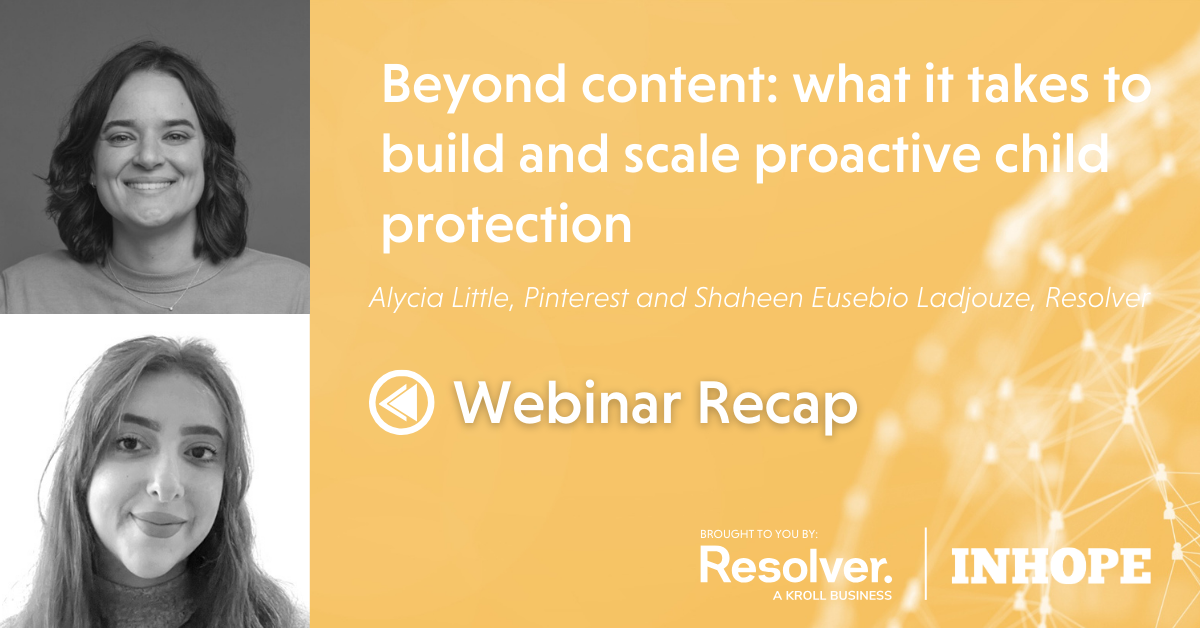Article
Events & Campaigns
Webinar Recap: Beyond content - what it takes to build and scale proactive child protection
Child safety online demands more than just reactive measures. In our latest webinar, Shaheen Eusebio Ladjouze, Senior Child Endangerment Analyst at Resolver Trust & Safety, and Alycia Little, Senior Child Safety Strategist at Pinterest, shared their insights on staying ahead of evolving threats, tackling the complexity of interconnected harms, and creating robust, adaptable safety measures.
The Evolution of Child Safety
The concept of child safety has evolved significantly - from being primarily focused on the physical world to encompassing a holistic approach that spans both online and offline environments. Alycia Little shared how her professional journey reflects this transformation. From working in correctional facilities and crisis centres to leading safety efforts in the tech sector, her understanding of harm has developed into what she describes as a “blended model”.
"For me, proactive is neatly nested with preventative. This involves studying trends, understanding social impacts, learning, building, testing, and then measuring that entire process as it comes to the prevention of harm." - Alycia Little
This proactive mindset is becoming increasingly critical as predatory behaviours evolve in response to new technologies and moderation strategies. Both speakers emphasised the need for safety professionals to stay agile and forward-thinking, anticipating changes and refining protective measures to stay ahead.
Content and Behaviour
Effective strategies require an understanding of both content patterns and user behaviour. Without addressing both aspects simultaneously, safety efforts risk becoming a frustrating game of "whack-a-mole," where focusing solely on content misses the crucial behavioural elements that drive harmful activities. Alycia Little used the analogy of "railroad ties" to illustrate this approach - two parallel tracks with essential cross-connections between them.
Both speakers acknowledged that implementing these strategies at scale poses significant challenges, particularly across different cultures and languages. While the goal is to build protections that work globally, creating perfect solutions for every cultural context isn’t always feasible. In these cases, Alycia Little recommends establishing clear "bright lines" where possible. Creating universally applicable standards rather than attempting to account for all cultural nuances will ensure that a baseline of safety is guaranteed for all users.
Standardisation shouldn’t stop at the organisational level. Sustainable and far-reaching strategies demand collaboration across the entire child safety ecosystem. As bad actors increasingly target weaker links and migrate across platforms, collective action and intelligence-sharing between stakeholders becomes essential.
Interconnected Threats
Enhanced cooperation becomes particularly vital as crimes in the online space become increasingly interconnected. Both speakers highlighted how crimes against children now overlap with other forms of illegal activity, including terrorist and extremist content, or trafficking.
"We're seeing the incorporation of many different risk areas. It's really hard to see harms as being exclusive to child safety." - Shaheen Eusebio Ladjouze.
While CSAM remains a central concern, the motivations behind these crimes have expanded, Alycia Little explained. This blending of previously distinct harm categories creates new challenges that require even more sophisticated approaches and deeper collaboration between diverse stakeholders.
The intertwining nature of these threats demands stronger partnerships between platforms, law enforcement, NGOs, and subject-matter experts. Effectively addressing these complex challenges requires not just identifying issues within individual platforms but sharing intelligence across the entire digital ecosystem.
Measuring Success
As we navigate this complex ecosystem of threats and collaborative responses, how do we know if our strategies are working?
- Establish a clear baseline before implementation
- Define appropriate measurement timeframes - rather than expecting instant results
- Choose metrics that align with your goals (e.g. user satisfaction for perception of safety, handle times for process efficiency)
- Recognise that sometimes success means the absence of incidents
Success is not always easy to measure. Sometimes, the best outcome is when nothing happens - when harm is prevented before it begins.
"Success to me is when we have the safeguards that users expect already in place. I don't want anyone to show up to a platform and experience a situation of unsafety and say 'I expected this to be here and it wasn't.'" - Alycia Little
"It Takes a Metropolis"
The ultimate goal is for safety measures to become second nature - seamlessly integrated in our lives, like seatbelts: once an innovation, now simply expected. But making online safety the new normal isn’t easy. As predatory behaviour becomes more sophisticated and harm becomes more interconnected, our response must evolve to match. It requires aligning on standards, sharing intelligence, and adapting faster than threat actors.
“It takes a village” no longer captures the scale of the challenge. As Alycia Little put it, keeping children safe online today takes a small metropolis, a coordinated network of platforms, experts, and organisations working across systems and borders.
Missed this webinar? Watch the full recording in our Webinar Playlist. Make sure to not miss the next one. Check out the full schedule.

This webinar was recorded and is available online. To watch it, visit our Webinar Playlist.
'